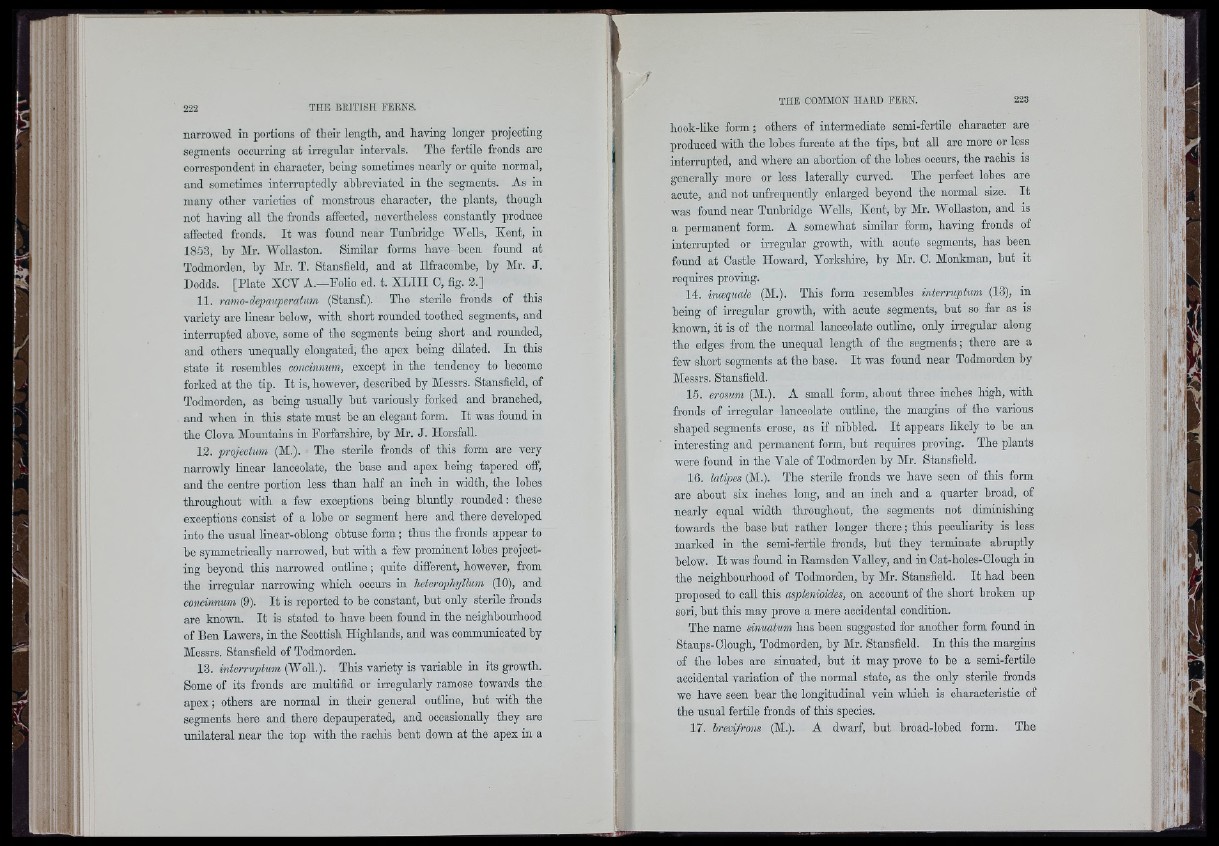
narrowed in portions of thoir length, and having longer projecting
segments ooourring at irregular intervals. Tho fertile fronds arc
correspondent in character, being sometimes nearly or quite normal,
and sometimes interruptedly abbreviated in the segments. As in
many other varieties of monstrous character, the plants, though
not having all the fronds affected, nevertheless constantly produce
affootod fronds. It was found near Tunbridge WeUs, Kent, in
1853, by Mr. WoUaston. Similar forms havo been found at
Todmorden, by Mr. T. Stansfield, and at Ilfraoombo, by Mr. J.
Dodds. [Plate XCV A.—FoUo ed. t. XLIII C, fig. 2.]
11. ramo-depauperatum (Stansf.). The sterile fronds of this
variety arc linear below, with short rounded toothed segments, and
interrupted above, some of the segments heing short and rounded,
and others unequaUy elongated, the apex being dilated. In this
state it resembles concinnum, except in the tendency to become
forked at the tip. It is, however, described by Messrs. Stansfield, of
Todmorden, as heing usuaUy but variously forked and branched,
and when in this state must bo an elegant form. It was found in
the Clova Mountains in Forfarshire, by Mr. J . Ilorsfall.
12. projectum (M.). The sterile fronds of this form are very
narrowly linear lanceolate, the base and apex being tapered off,
and the centre portion less than half an inch in width, the lobes
throughout with a few exceptions being bluntly rounded: tbese
exceptions consist of a lobe or segment here and there developed
into the usual linear-ohlong obtuse form; thus the fronds appear to
he symmetricaUy narrowed, bnt with a few prominent lohes projecting
beyond tbis narrowed outline ; quite different, however, from
the irregular narrowing which occurs in heterophyllum (10), and
concinnum (9). It is reported to be constant, but only sterUe fronds
are known. It is stated to have been found in tbo neigbbourhood
of Ben Lawers, in the Scottish Highlands, and was communioated by
Messrs. Stansfield of Todmorden.
13. interruptum (WoU.). This variety is variable in its growth.
Some of its fronds are multifid or irregularly ramose towards the
apex; others are normal in their general outUne, but with the
segments here and there depauperated, and occasionaUy they are
unilateral near the top with the raohis bent down at the apex in a
hook-like form ; others of intermediate semi-fortUe character are
produced with the lohes furcate at tho tips, but all aro more or less
interrupted, and where an abortion of the lohes occurs, the rachis is
generaUy more or less lateraUy curved. The perfect lobes are
acute, and not unfrequently enlarged beyond the normal size. It
was found near Tunbridge WeUs, Kent, by Mr. WoUaston, and is
a permanent form. A somewhat similar form, having fronds of
interrupted or irregular growth, with acute segments, has been
found at Castle Howard, Yorkshire, by Mr. C. Monkman, hut it
requires proving.
14. inmquale (M.). This form resembles interruptum (13), in
being of irregular growth, with acute segments, but so far as is
known, it is of the normal lanceolate outUne, only irregular along
the edges from the unequal length of the segments; there aro a
few short segments at the base. It was found near Todmorden by
Messrs. Stansfield.
15. erosum (M.). A smaU form, about three inches high, with
fronds of irregular lanceolate outline, the margins of the various
shaped segments erose, as if nibbled. It appears likely to be an
interesting and permanent form, but requires proving. The plants
were fonnd in the Vale of Todmorden by Mr. Stansfield.
16. latipes (M.). The sterile fronds we have seen of this form
are about six inches long, and an inch and a quarter broad, of
nearly equal width throughout, the segments not diminishing
towards the base but rather longer there; this peculiarity is less
marked in the semi-fertUe fronds, hut they terminate abruptly
holow. It was found in Eamsden VaUey, and in Cat-holes-Glough in
the neighbourhood of Todmorden, by Mr. Stansfield. It had been
proposed to oaU this asplenioides, on account of the short broken up
sori, but this may prove a mere accidental condition.
The name sinuatum has been suggested for another form found in
Staups-Clough, Todmorden, by Mr. Stansfield. In this the margins
of the lobes are sinuated, but it may prove to be a semi-fertUe
accidental variation of the normal state, as the only sterile fronds
we have seen hear the longitudinal vein which is charaoteristie of
the usual fertile fronds of this species.
17. hrevifrons (M.). A dwarf, hut hroad-lobed form. The
l‘
I'f'.
' I
I 1 Ii
, t
ft"
I I
m m
I' ti-T
i.il
'ir